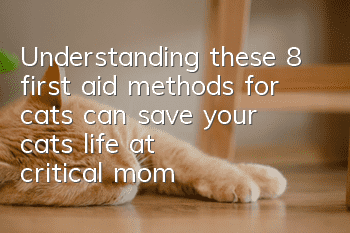Understanding these 8 first aid methods for cats can save your cat’s life at critical moments!

Cats have a long history as human pets, but they have not lived with us as companion animals for long. Now they no longer have the responsibilities of catching mice and guarding food as they did in the beginning, but more Its function is to help the owner regulate emotions and relieve stress. These furry little guys who live with us are full of energy, especially when they are underage, and they are ignorant of many things around them.
Let’s take a look at what unexpected accidents we may encounter in our daily lives, and how to deal with them correctly in the first place!
01. Coma
When you find your cat unconscious, you should first get it out of danger and then take it to the veterinarian immediately. Use a blanket as a stretcher, lay the cat flat and gently place it on the blanket. Carefully lift the blanket and place it on a stable surface. If your cat has trouble breathing, lay her on her side with her head down. Open its mouth and pull its tongue forward. Use cotton wool to gently wipe away mucus from your mouth. Do not let the cat lie on its side for more than 5 to 15 minutes, and do not feed it any food. When taking your cat to the hospital, lower the blanket into a secure crate or flight box.
02. Bandage
When applying a bandage to your cat, remember to apply it firmly, but not too tightly, otherwise it will hinder local blood circulation. Clean the area before applying a bandage. If there is trauma, clean it with saline, dry it, wrap it with gauze, and then tie it with a bandage. If local swelling occurs after applying the bandage, it needs to be loosened and applied again.
03. Bleeding
First find the bleeding wound, and then quickly cut off the hair around the wound. If there are any foreign objects such as glass fragments, they must be removed first. When the bleeding is small, you can clean the wound with tap water or 3% diluted hydrogen peroxide, then apply gauze and wrap a bandage to stop the bleeding; if the bleeding is serious, The patient should first stop bleeding and then be sent to the hospital immediately. If the wound is on the chest or abdomen, apply pressure with gauze. If the bleeding still does not stop, use ice to apply cold compress. Ropes and sticks can also be used to stop bleeding. It should be noted that it must be loosened every 15 minutes to prevent tissue necrosis at the end.
04. Fracture
When a cat limps or staggers when walking, these are signs of a fracture. Parents should try not to let the cat move and avoid touching its affected areas to avoid bone fragments from injuring blood vessels or nerves and other tissues. Parents can place it in the flight box to reduce its range of activities and send it to the doctor in time. If parents have common sense about pet first aid, they can use splints to fix fractures by themselves. However, if they are not trained, they can refer to the following methods or ask a veterinarian for help. ①Wrap the fractured area with cotton, then tie it with a bandage toReduce the shock caused by movement; ② Place two suitable and strong wooden boards on both sides of the fracture, and wrap it firmly with a bandage again.
05. Bite
Bites or scratches caused by fights between cats, no matter how small the wound, are prone to suppuration. This is because a type of bacteria in the cat's toenails or mouth can easily cause suppuration in the subcutaneous tissue below the wound. When you find a bite or scratch, be sure to disinfect it carefully first.
06. Scalds or burns
If the cat is accidentally scalded or burned, the owner should immediately wash the injured area with clean water. It is best to let the water flow continuously to rinse the wound for about 10 minutes. This is because the cat’s coat is thick and it takes a while for the water to penetrate the skin at the roots of the hair. In addition, it is not easy to dissipate heat and cool down when hot water is poured on the body. , so there is a continuous flow of water through the wound, which helps to alleviate the high temperature on the skin surface and reduce the damage to the skin tissue. Sometimes parents will apply ice cubes to the affected area, but do not apply ice for too long, otherwise the skin will die quickly. Do not let it lick the affected area, otherwise it will increase the chance of bacterial infection of the wound.
07. Falling from the building
Once a cat falls from a tall building, parents should rush downstairs immediately to check the cat's injuries. Cats that fall from a height usually show symptoms of nose and mouth bleeding, fractures, unconsciousness, and even shock. Parents should stay calm, contact a doctor in time, and perform simple hemostasis or immobilization of the injured cat under professional guidance. After that, he was quickly sent to the hospital. Parents who live in high-rise buildings should pay attention to closing windows or balconies every day, or they can add safety nets outside windows and balconies, which can save lives in critical moments.
08. Drowning
Cat hair is fine and less oily, so it cannot discharge water and is most afraid of getting wet. Although there are cats that are good at swimming, they are not good at swimming for long periods of time. For first aid for drowning cats, use both hands to hold the hind legs, hang them upside down for 10 to 20 seconds, and then swing them up and down 3 to 4 times to spit out the water that has entered the cat's lungs and send it to the doctor in time.
As the saying goes - curiosity killed cats. As their owners and guardians, we should know some simple first aid and nursing common sense. When they unfortunately have an accident, we can respond correctly at the first time and minimize casualties and losses. .
- How many teeth does a cat have?
- Why do wild cats scream in the middle of the night?
- How soon after birth can a cat be vaccinated?
- How to identify "imported cat food" and "originally imported cat food"?
- Can kittens eat corn-flavored ham?
- Precautions for male cats after neutering surgery
- What does castrated male cat mean?
- Can cats eat sweets? Can cats eat sweets?
- What to do if a cat is poisoned by aflatoxin? What are the first aid methods?
- What does "little milk cat" mean? How old is a cat?



